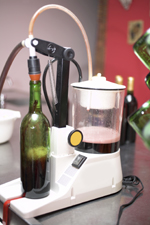Monthly Winemaking Considerations

Jan/Feb For winemakers of white wine, by now your prior year's vintage wines should have been racked several times and the wines ought to be totally clear. They should be through cold stabilization as well and have adequate potasium metabisulfite to preserve.
For red wines, they should have been racked a number of times by now and are now ready to be stored in barrels for aging. If you do not use barrels but want some oak flavor, chips or other form of oak can now be added to taste. Check the sulfite in the wine to insure appropriate preservation amount.
March/April White wines that are to be finished off as off-dry or sweet need to be prepared now by adding Potasium Sorbate. If you are experimenting with flavor infusions, now would be the right time to finalize your plans and add. Purchase your bottles or get your used bottles cleaned in prep for the bottling process. Make sure you have enough corks and any labels you might want. April is a great month to bottle the whites, before the nice weather and new grape growing season starts. Get your filter equipment, including filter pads or cartridges, ready if you filter your wines. Bottle the wines and lay them down and start drinking.
For reds, if your wines are in barrels, taste them on a regular, every few weeks, basis. Check the sulfite level and top off the wine. The wine must always be at the top of the barrel; no air space. If the wines is in glass or stainless, taste regularly as above and assure the sulfites are OK. If you added oak chips, they have probably sunk by now. If the wine needs more oak you can add an additional amount, as before. The sunken chips can be removed at your next racking. If the oak content is to your liking, remove the wine from the barrel and continue to store in glass or stainless. Bottling of reds should be held off to allow the flavors in the wine meld and mellow throughout the wine. This is alwasy better accomplished in bulk storage rather than in bottles.
If you are planning to purchase Chilean grapes, now is the time to place your orders and plan on crushing/destemming. Get your equipment ready as well as purchasing your yeasts, M-L innoculants if you want, and other additives as necessary. As a tip, if you make a Chilean Malbec in the spring, you can use the wine as a great coloring additive for your California wines next fall as well as enjoying the wine on its own. Malbec is an intensely dark, rich tasting wine. For coloring purposes it is head and shoulders above Alicante and should be considered.
May/June/July
Whites
By this point in time all white wines from the Northern hemisphere vintage should be bottled unless you are barrel aging, such as Chardonnay. If so be vigilant not to over oak if using a new barrel. Spend the rest of the summer planning for the recent white grape vintage.
White wines from Chile should be completing their second racking and be fairly clear. Check for proper sulfite level based on the pH. Keep the wines as cool as possible as we approach the hottest part of our summer. Start planning for the bottling of the wines during the fall season.
Reds
Red wines from the most recent Northern Hemisphere vintage should have been racked a number of times by now, perhaps three times, and should be completely clear. Aging should continue through the summer months. Malolactic fermentation should also be completed; you may want to confirm with some testing (color chromatography, for example). Watch temperature fluctuations in the storage area. Most garages are not suitable if the temperature goes up during the day and drops at night. Sulfite levels need to me carefully monitored to maintain appropriate ppm based on the pH of the wine. Insure that barrels are topped off every two weeks. Glass and stainless containers should also have minimum airspace. Wines should be tasted periodically to assure everything is aging well. If a problem appears you must remedy it quickly before things get out of hand.
Red wines from Chile should be ready for a first or second racking, at this point, depending of when they were fermented. For those with a delayed fermentation, pressing should be completed and wines stored in glass or stainless sealed containers. Over the next month the wines should be racked once or twice before being placed into barrels. For wines intended for glass or stainless storage, another racking can be performed in late summer. As above, top off barrels every two weeks and eliminate airspace as much as possible. Monitor sulfite levels and adjust accordingly based on pH of the wine. Periodically taste the wine to monitor progress and watch for faults.